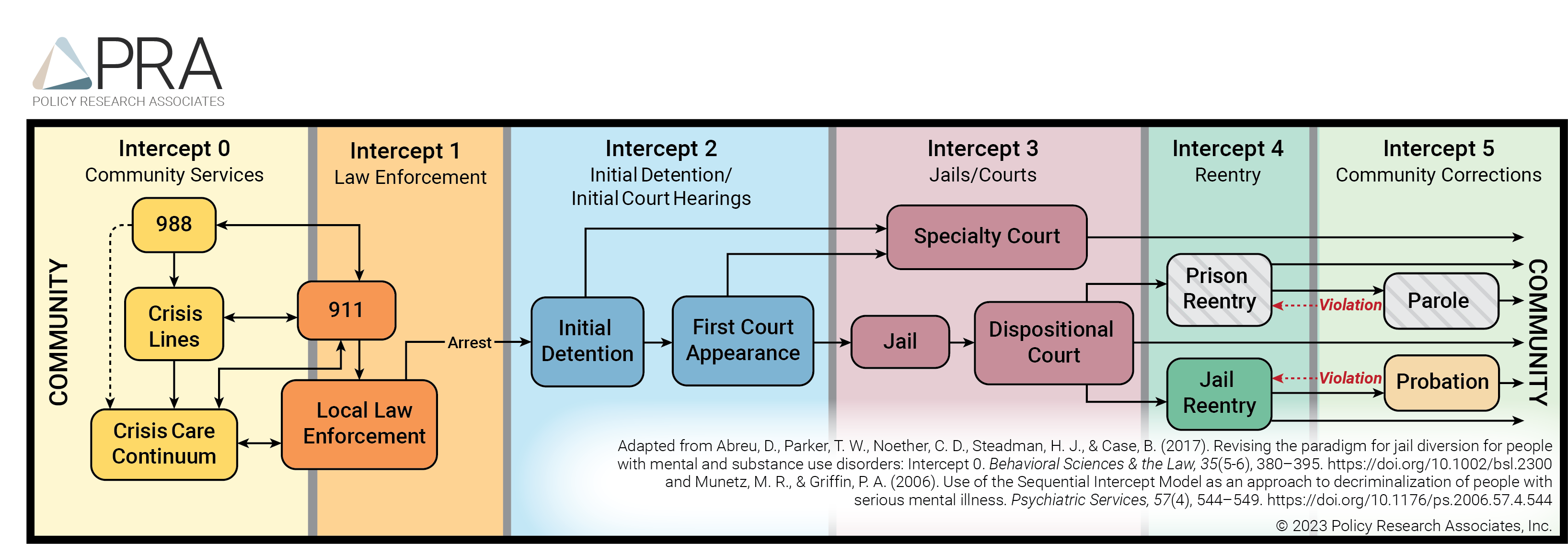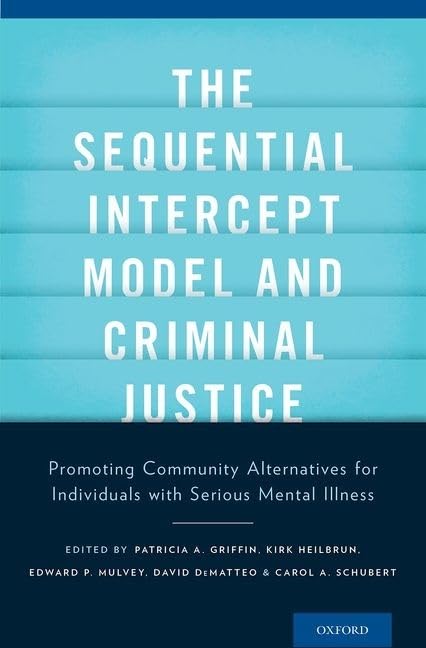The Sequential Intercept Model

The Sequential Intercept Model (SIM) is a conceptual model used to inform community-based responses to the involvement of people with mental and substance use disorders in contact with the criminal legal system. It identifies key “intercepts” ranging from community-based crisis care through law enforcement, courts, and reentry. Communities use the SIM to map their criminal legal and behavioral health systems. Using the SIM, they can identify resources, close service gaps, and promote the use or expansion of evidence-based interventions. The SIM encourages collaboration to provide people with the right resources at the right time.


Using the SIM as a Strategic Planning Tool
The Sequential Intercept Model is most effective when it is used as a community strategic planning tool to assess available resources, determine gaps in services, and plan for community change. These activities are best accomplished by a team of community partners that cross over multiple systems, including mental health, substance use, law enforcement, pretrial services, courts, jails, community corrections, crisis care, housing, health, social services, people with lived experiences, family members, and many others. Communities can use the Sequential Intercept Model to achieve the following:
- Develop a comprehensive picture of how people with mental and substance use disorders flow through the criminal legal system along six distinct intercept points.
- Identify gaps, resources, and opportunities at each intercept for adults with mental and substance use disorders.
- Develop priorities for action to improve system and service-level responses for adults with mental and substance use disorders.
Sequential Intercept Model Mapping Workshops strengthen a community’s ability to respond to the involvement of people with behavioral health conditions in contact with the criminal legal system. Policy Research tailors Sequential Intercept Model Mapping Workshops to a community’s specific needs—whether that be focusing on a population (e.g., people with acquired brain injury), treatment need (e.g., substance use disorder treatment), or intercept (e.g., community reentry from jail or prison).
Using the SIM as a Research and Evaluation Tool
The SIM provides a structured framework for research and evaluation studies related to criminal legal and behavioral health systems. Its prominence in the field, coupled with its clear delineation of criminal legal system intercepts, makes it a valuable tool for the following:
- Identifying potential partners and informants for a project
- Outlining current practices, policies, gaps, and priorities for evaluation
- Designing data collection and sampling strategies within and across intercepts
- Organizing the coding and presentation of data, findings, and recommendations
- Informing analytic strategies and sequencing of variables for qualitative and quantitative models
- Aligning findings with best-practice guidelines at each intercept

The SIM’s Impact in the Field
“Community levels, crisis response, interaction with law enforcement, involvement with the criminal justice system, jail or specialty courts, parole and finally back into the community — what type of resources are available, and where do the gaps lie?”
“Sometimes somebody commits an offense, and they need to go to prison for a long time, and those are pretty easy to discern, but a lot of times somebody does it, and they don’t necessarily need to be incarcerated. But they need to be someplace where they can be kept safe and society can be kept safe.”
This workshop will both identify the services that already exist within our community, and work to enhance the connections to them in an effort to assist individuals seeking recovery for their substance use and/or criminal justice involvement.”
“This is an opportunity to improve public safety, to save public dollars, and more importantly to get people the treatment they need when they need it rather than keep cycling through our system and not getting the treatment they need,”

History and Impact of the SIM


Best Practices at Each Intercept
Intercept 0: Community Services
Mobile crisis outreach teams and co-responders. Behavioral health practitioners who can respond to people experiencing a mental or substance use crisis or co-respond to a law enforcement encounter.
Emergency department (ED) diversion. ED diversion can consist of a triage service, embedded mobile crisis, or a peer specialist who provides support to people in crisis.
Law enforcement-friendly crisis services. Law enforcement officers can bring people in crisis to locations other than jail or the ED, such as stabilization units, walk-in services, or respite centers.
Dispatcher training. Dispatchers should coordinate with 988 and understand triage protocols.
Intercept 1: Law enforcement
Dispatcher training. Dispatchers can identify mental or substance use crisis situations and pass that information along so that Crisis Intervention Team officers can respond to the call. They should coordinate with 988 and understand triage protocols.
Specialized law enforcement responses. Law enforcement officers can learn how to interact with people experiencing a crisis in ways that promote engagement in treatment and build community partnerships.
Intervening with people who have frequent behavioral health crises and/or jail contact and providing follow-up after the crisis. Law enforcement officers, crisis services, and hospitals can provide specialized responses to people who frequently use 911 and emergency department services.
Intercept 2: Initial Detention and Initial Court Hearings
Screening for mental and substance use disorders. Brief screens can be administered universally by non-clinical staff at jail booking, holding cells, court lock ups, and prior to the first court appearance.
Data-matching initiatives between the jail and community-based behavioral health providers. Jail-led efforts to share information with community-based providers may be effective due to more restrictive rules related to information sharing for behavioral health providers.
Pretrial supervision and diversion services to reduce episodes of incarceration. Risk-based pre-trial services can reduce incarceration of people with low risk of criminal behavior or failure to appear in court.
Intercept 3: Jails and Courts
Treatment courts for high-risk/high-need individuals. Treatment courts or specialized dockets can be developed, examples of which include adult drug courts, mental health courts, and Veterans Treatment Courts.
Jail-based programming and health care services. Jail healthcare providers are constitutionally required to provide behavioral health and medical services to persons needing treatment.
Collaboration with the Veterans Justice Outreach (VJO) specialist from the Veterans Health Administration (VHA). VJO specialists can support Veterans by connecting them with VHA-provided services and other benefits to support recovery.
Intercept 4: Reentry
Transition planning by the jail or in-reach providers. Transition planning improves reentry outcomes by organizing services around a person’s needs in advance of release.
Medication and prescription access upon release from jail or prison. People should be provided with a minimum of 30 days’ medication at release and have prescriptions in hand upon release.
Warm hand-offs from corrections to providers increase engagement in services. Case managers and peer support specialists can play an important role in supporting individuals in their recovery and community reintegration. They can assist with navigating the myriad demands placed on an individual, including transportation and scheduling, increasing positive outcomes.
Intercept 5: Community Corrections
Specialized community supervision for people with mental and substance use disorders. Officers trained on the complexities of mental and substance use disorders can support connection to community-based services and supports.
Medication-assisted treatment (MAT) for people with substance use disorders. MAT approaches can reduce relapse episodes and overdoses among individuals returning from detention.
Access to recovery supports, benefits, housing, and competitive employment. Housing and employment are as important to criminal legal system-involved individuals as access to treatment services. Removing barriers to access is critical.









